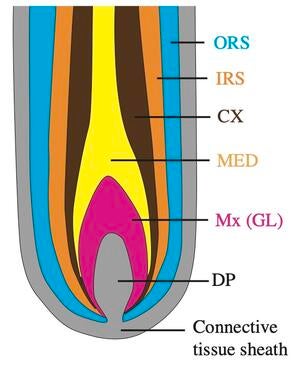2022-07-25 ミシガン大学
 An artistic rendering of multituberculates from the genus Mesodma—a mother with her litter of offspring—who lived in western North America 60 to 70 million years. Fossil evidence indicates that these creatures were the most abundant mammals in western North American just before and directly after the mass extinction event 66 million years ago that killed off the dinosaurs. Image credit: Andrey Atuchin
An artistic rendering of multituberculates from the genus Mesodma—a mother with her litter of offspring—who lived in western North America 60 to 70 million years. Fossil evidence indicates that these creatures were the most abundant mammals in western North American just before and directly after the mass extinction event 66 million years ago that killed off the dinosaurs. Image credit: Andrey Atuchin
研究者らは、哺乳類の別のグループである絶滅した有袋類が胎盤に似た様式で繁殖していた可能性を示す研究結果を、7月18日付けの「The American Naturalist」誌オンライン版に発表しました。多弓類は胎盤動物や有袋類が進化する前に他の哺乳類の系統から分離したため、この発見は、有袋類が胎盤動物の仲間よりも「進化していない」とする見解に疑問を投げかけるものである。
<関連情報>
- https://news.umich.edu/new-study-challenges-old-views-on-whats-primitive-in-mammalian-reproduction/
- https://www.journals.uchicago.edu/doi/10.1086/720410
多弓類の哺乳類は、有袋類ではなく、無袋類に類似した生活史戦略の証拠を示している Multituberculate Mammals Show Evidence of a Life History Strategy Similar to That of Placentals, Not Marsupials
Lucas N. Weaver,Henry Z. Fulghum,David M. Grossnickle,William H. Brightly,Zoe T. Kulik,Gregory P. Wilson Mantilla, and Megan R. Whitney
The American Naturalist Published:July 18, 2022
DOI:https://doi.org/10.1086/720410
Abstract
The remarkable evolutionary success of placental mammals has been partly attributed to their reproductive strategy of prolonged gestation and birthing of relatively precocial, quickly weaned neonates. Although this strategy was conventionally considered derived relative to that of marsupials with highly altricial neonates and long lactation periods, mounting evidence has challenged this view. Until now the fossil record has been relatively silent on this debate, but here we find that proportions of different bone tissue microstructures in the femoral cortices of small extant marsupials and placentals correlate with length of lactation period, allowing us to apply this histological correlate of reproductive strategies to Late Cretaceous and Paleocene members of Multituberculata, an extinct mammalian clade that is phylogenetically stemward of Theria. Multituberculate bone histology closely resembles that of placentals, suggesting that they had similar life history strategies. A stem-therian clade exhibiting evidence of placental-like life histories supports the hypothesis that intense maternal-fetal contact characteristic of placentals is ancestral for therians. Alternatively, multituberculates and placentals may have independently evolved prolonged gestation and abbreviated lactation periods. Our results challenge the hypothesis that the rise of placental mammals was driven by unique life history innovations and shed new light on early mammalian diversification.


